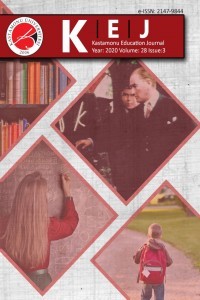The teaching of historical events in terms of change and continuity in high school history courses: An Application Example for 9th Grade
The teaching of historical events in terms of change and continuity in high school history courses: An Application Example for 9th Grade
Purpose: The aim of this study is to determine the effect of high school students' (15–16-year-old) activity studies on the concept of historical change and continuity in the classroom environment in terms of historical change and continuity teaching.
Design, Methodology, and Approach: The experimental design model with a pretest and posttest control group is used in this study. The model of the study is a mixed research method. The research group consisted of 9th grade students from a high school affiliated with the Çanakkale Provincial Directorate of National Education, as determined by an easily accessible sampling method. In the high school where the research was carried out, the A and B branches, consisting of 9th grade students, were divided into experimental and control groups, randomly. 20-21 in the experimental group; the control group consisted of 25 students. No application in the study was made to control group. The invention of writing was explained to the students in the experimental group for 6 weeks (24 hours at total), accompanied by historical change and continuity activities. A total of 40 minutes was given for each of the activities given to the students in the study. He used visual material in each given activity. In the study, data were collected and analyzed in accordance with quantitative and qualitative research techniques. The quantitative data of the study consisted of the scores given by the raters for the historical change and continuity texts prepared by the students in the experimental and control groups about the invention of writing before and after the application.
Findings: The findings of this study clearly showed that the activities given in the application led to significant differences between the pre-test and post-test texts of the students for an effective understanding of historical change and continuity. At the same time there were significant differences between experiment and control groups for this skills. After the application, experiment group adopted a more systematic approach in their texts. The means and standard deviations of the experimental and control group text analyzes before the application were 3.87±2.16 and 2.95±1.19, respectively. There were no statistically significant differences between the experimental and control groups before the application (p: 0.098). After the application, the means and standard deviations of the experimental and control groups were 10.36±3.06 and 2.88±1.46, respectively. The differences between post-test and pre-test results, as well as the t-test results, were found to be highly significant (p<.001). Similarly, the differences between the pretest and posttest are statistically significant (p<.001).
Highlights: In this study it was obviously seen that student's historical change and continuity perception can be developed with effective methods and techniques in high school history courses, especially using historical change and continuity visual activities. At the same time, no matter what historical issue, historical change and continuity in history courses can be taught at earlier age. In this study, the students of experiment group were able to build their own historical knowledge using the invention of writing as an example when compared to control group.
Keywords:
History teaching, Historical thinking, Choronology Change, Contuinity,
___
- Blow, F. (2011). 'Everything flows and nothing stays': how students make sense of the historical concepts of change, continuity and development. Teaching History, 145, 47-55.
- Büyüköztürk, Ş. (2001). Deneysel desenler, ön test-son test, kontrol grubu desen ve veri analiz kitabı, Ankara.
- Cooper, H (1991). Young Children’s thinking in History. Doctoral Dissertation, London University Institute of Education, United Kingdom.
- Yayın Aralığı: Yılda 4 Sayı
- Başlangıç: 1995
- Yayıncı: Kastamonu Üniversitesi
Sayıdaki Diğer Makaleler
Ali KAYMAK, Hasan Fersat TAŞLIBEYAZ, Metehan KUTLU, Erkan ARI
Dilek İLHAN BEYAZTAŞ, Yakup BOSTANCI
Hülya SADIK YILMAZ, Hamza KELEŞ
Onur Can PEHLİVAN, Gülay ASLAN
How Well Do International Students Adapt to The Turkish Higher Education System?
Curriculum Implementation Approaches of Secondary School English Teachers: A Case Study
Gülçin ÇELİKER ERCAN, Zühal ÇUBUKÇU
Analysis of Postgraduate Thesis Studies in English Medium Instruction (EMI) in Turkey
